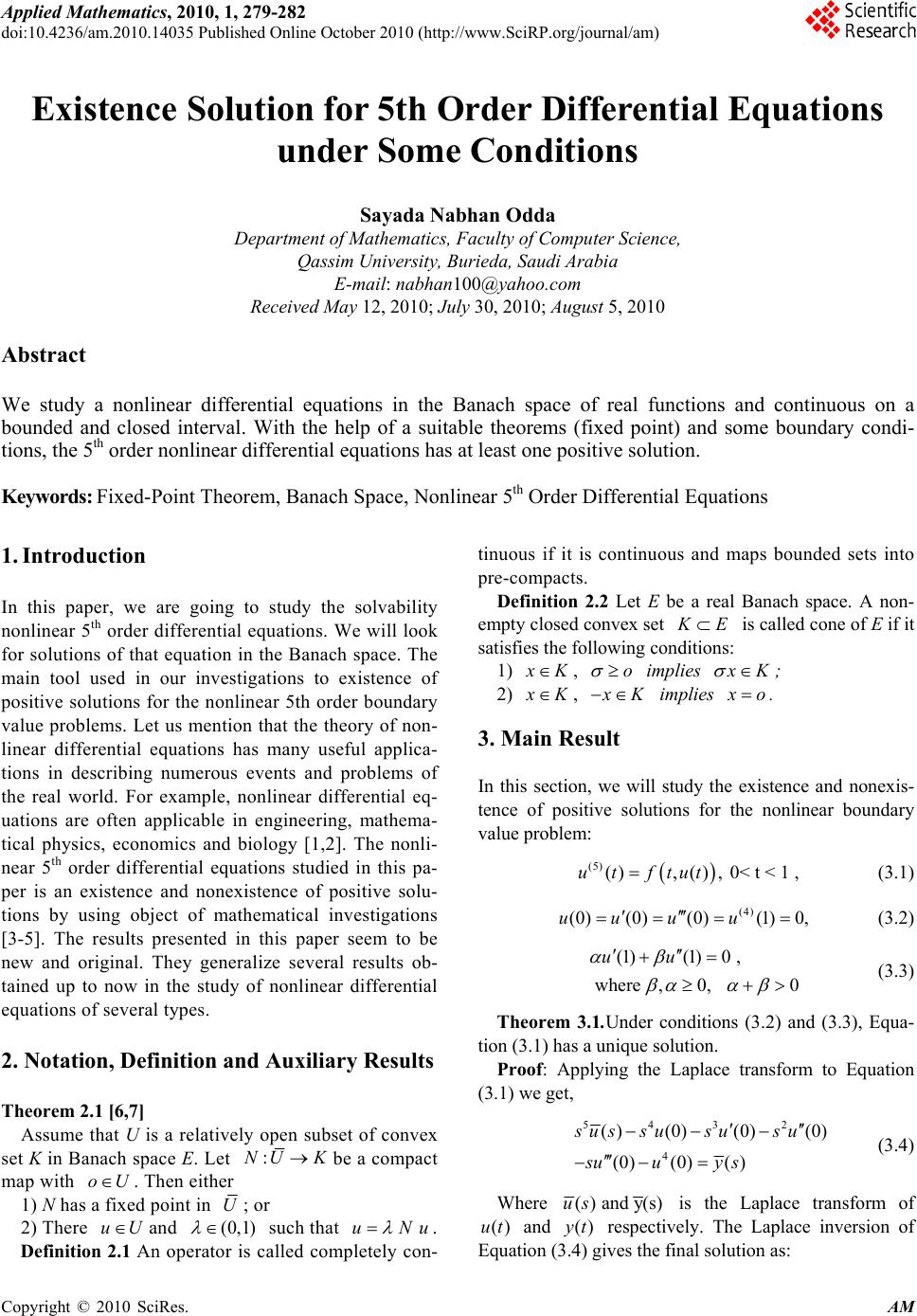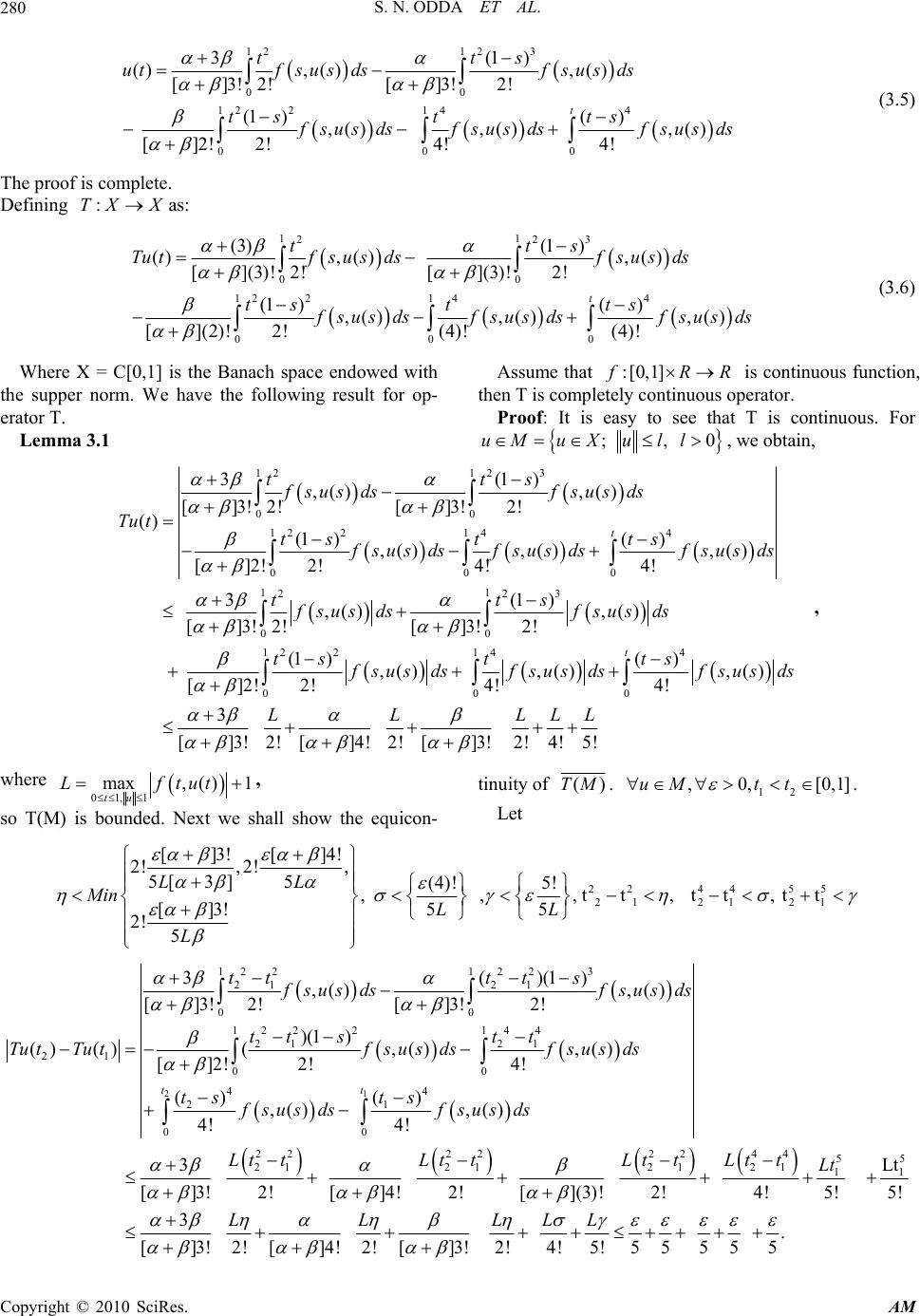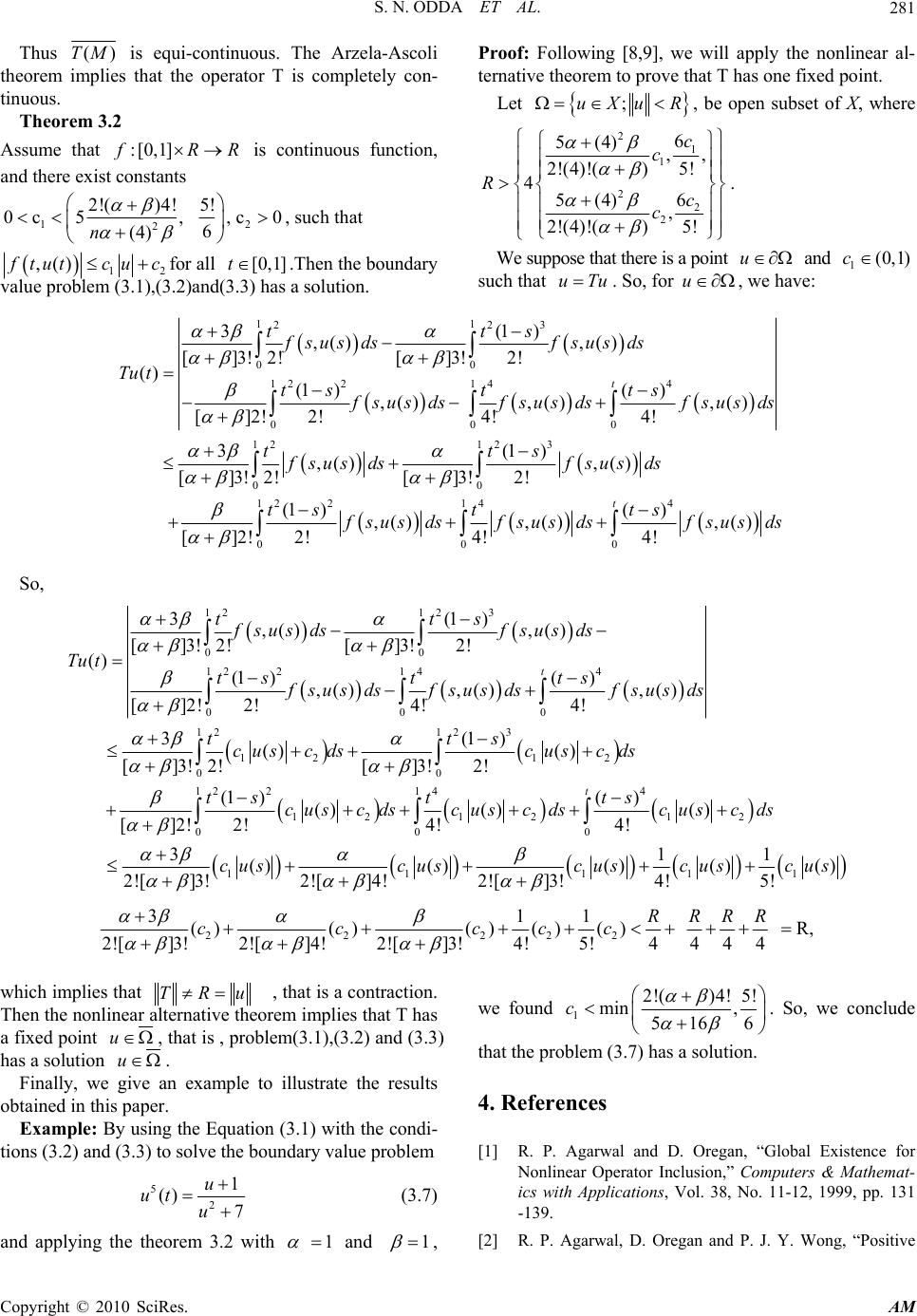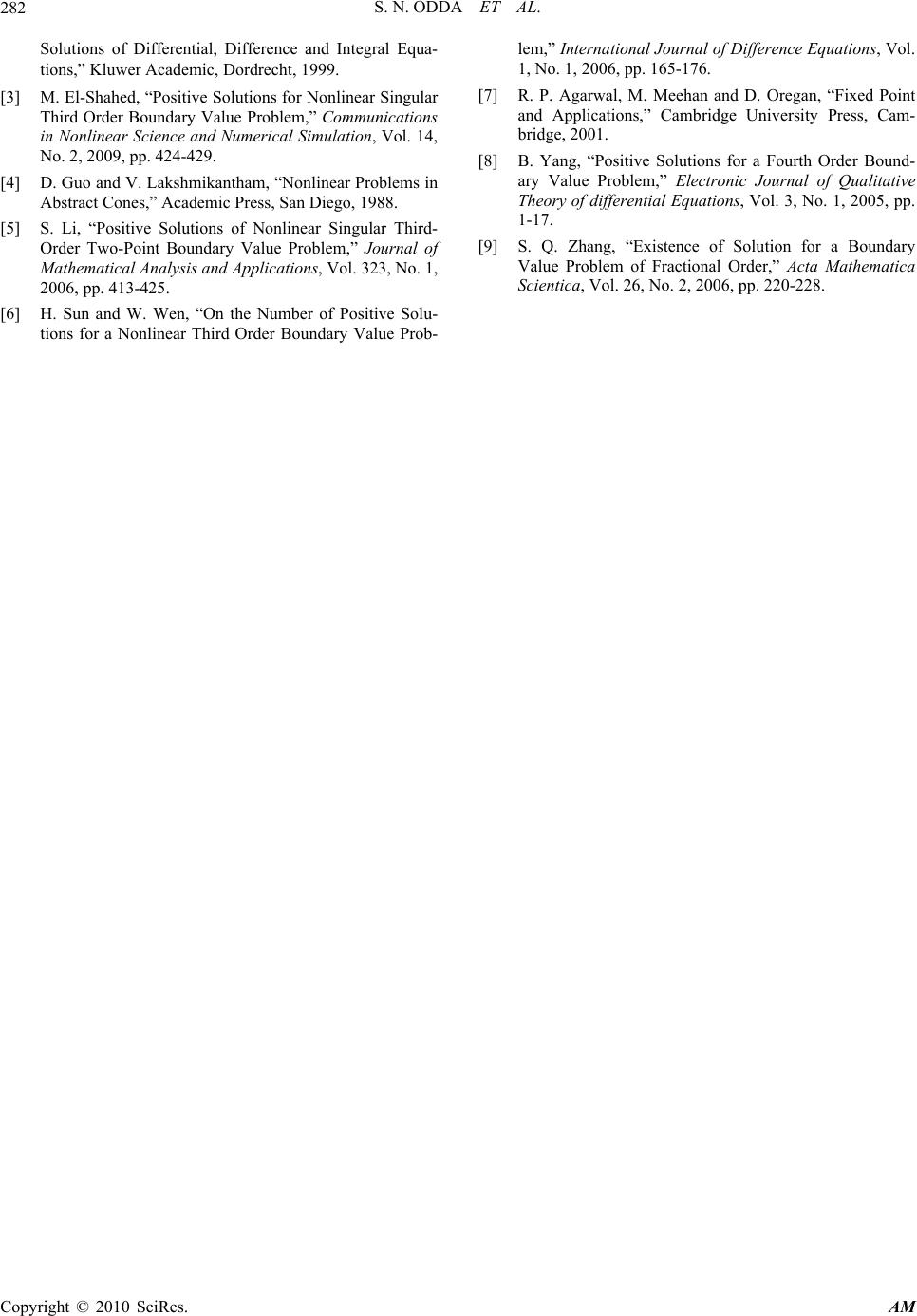Paper Menu >>
Journal Menu >>
 Applied Mathematics, 2010, 1, 279-282 doi:10.4236/am.2010.14035 Published Online October 2010 (http://www.SciRP.org/journal/am) Copyright © 2010 SciRes. AM Existence Solution for 5th Order Differential Equations under Some Conditions Sayada Nabhan Odda Department of Mat he matics, Facul t y of Co mp ut er Sci e nce , Qassim University, Burieda, Saudi Arabia E-mail: nabhan100@yahoo.com Received May 12, 2010; July 30, 20 1 0; August 5, 2010 Abstract We study a nonlinear differential equations in the Banach space of real functions and continuous on a bounded and closed interval. With the help of a suitable theorems (fixed point) and some boundary condi- tions, the 5th order nonlinear differential equations has at least one positive solution. Keywords: Fixed-Point Theorem, Banach Space, Nonlinear 5th Order Differential Equations 1. Introduction In this paper, we are going to study the solvability nonlinear 5th order differential equations. We will look for solutions of that equation in the Banach space. The main tool used in our investigations to existence of positive solutions for the nonlinear 5th order boundary value problems. Let us mention that the theory of non- linear differential equations has many useful applica- tions in describing numerous events and problems of the real world. For example, nonlinear differential eq- uations are often applicable in engineering, mathema- tical physics, economics and biology [1,2]. The nonli- near 5th order differential equations studied in this pa- per is an existence and nonexistence of positive solu- tions by using object of mathematical investigations [3-5]. The results presented in this paper seem to be new and original. They generalize several results ob- tained up to now in the study of nonlinear differential equations of several types. 2. Notation, Definition and Auxiliary Results Theorem 2.1 [6,7] Assume that U is a relatively open subset of convex set K in Banach space E. Let :NU Kbe a compact map w ith oU. Then either 1) N has a fixed point in U; or 2) There uUand (0,1) such that uNu . Definition 2.1 An operator is called completely con- tinuous if it is continuous and maps bounded sets into pre-compacts. Definition 2.2 Let E be a real Banach space. A non- empty closed convex set K E is called cone of E if it satisfies the following conditions: 1) x K , o implies x K ; 2) x K , x K implies x o. 3. Main Result In this section, we will study the existence and nonexis- tence of positive solutions for the nonlinear boundary value problem: (5) (),(), 0< t < 1 ,ut ftut (3.1) (4) (0)(0)(0)(1) 0,uu uu (3.2) (1)(1)0 , where ,0, 0 uu (3.3) Theorem 3.1.Under conditions (3.2) and (3.3), Equa- tion (3.1) has a unique solution. Proof: Applying the Laplace transform to Equation (3.1) we get, 543 2 4 ( )(0)(0)(0) (0)(0)() sus sususu suuy s (3.4) Where () and y(s)us is the Laplace transform of ()ut and ()yt respectively. The Laplace inversion of Equation (3.4) gives the final solution as:  S. N. ODDA ET AL. Copyright © 2010 SciRes. AM 280 11 223 00 11 22 44 000 3(1) (), (), () []3!2! []3!2! (1 )() ,() ,() ,() []2! 2!4!4! t tts ut fsusdsfsusds tst ts f sus dsfsus dsfsus ds (3.5) The proof is complete. Defining :TX Xas: 11 223 00 11 22 44 000 (3)(1 ) (),() ,() [](3)! 2!2! (1 )() ,(),() ,() [](2)! 2!(4)!(4)! t tts Tutfsusdsf susds ts tts f sus dsfsus dsfsus ds (3.6) Where X = C[0,1] is the Banach space endowed with the supper norm. We have the following result for op- erator T. Lemma 3.1 Assume that :[0,1] f RR is continuous function, then T is completely continuous operator. Proof: It is easy to see that T is continuous. For ; , 0uMuX ull , we obtain, 11 223 00 11 22 44 000 11 223 00 3(1) ,() ,() []3!2! []3!2! () (1 )() ,(),() ,() []2! 2!4!4! 3(1) ,(),() []3! 2![]3!2! t tts fsusds fsusds Tu tts tts fsusdsfsus dsfsus ds tts fsus dsfsus ds 11 22 44 000 (1 )() ,() ,(),() []2!2!4!4! 3 []3! 2! []4!2! []3!2!4!5! t tst ts f sus dsfsus dsfsus ds LL LLL , where 01, 1 max,()1 tu Lftut , so T(M) is bounded. Next we shall show the equicon- tinuity of ()TM . 12 ,0, [0,1]uMt t . Let 2244 55 2121 21 []3![]4! 2!,2! , 5[ 3]5(4)! 5! , ,, tt, tt, tt []3! 55 2! 5 LL Min LL L 21 2222 3 11 21 21 00 22 244 11 21 21 21 00 44 21 00 ()(1) 3,() ,() []3! 2![]3!2! )(1 ) ()()(,() ,() [ ]2!2!4! () () ,() ,() 4! 4! tt tttt s fsusds fsusds tt stt Tut Tutfsusdsfsusds ts ts fsusds fsusds 22222244 55 21212121 11 Lt 3 []3! 2![]4! 2! 2!4!5!5! 3 . []3!2![]4!2! []3!2!4!5!5 55 55 LttLttLttLttLt LL LLL  S. N. ODDA ET AL. Copyright © 2010 SciRes. AM 281 Thus ()TM is equi-continuous. The Arzela-Ascoli theorem implies that the operator T is completely con- tinuous. Theorem 3.2 Assume that :[0,1] f RR is continuous function, and there exist constants 12 2 2!()4! 5! 0c5, , c0 6 (4)n , such that 12 ,() f tutcucfor all [0,1]t .Then the boundary value problem (3.1),(3.2)and(3.3) has a solution. Proof: Following [8,9], we will apply the nonlinear al- ternative theorem to prove that T has one fixed point. Let ;uXu R , be open subset of X, where 21 1 22 2 6 5(4) ,, 2!(4)!() 5! 46 5(4) , 2!(4)!() 5! c c Rc c . We suppose that there is a point u and 1(0,1)c such that uTu . So, for u, we have: 11 223 00 11 22 44 000 11 223 00 3(1) ,() ,() []3! 2![]3!2! () (1 )() ,() ,(),() []2! 2!4!4! 3(1) ,() ,() []3!2! []3!2! [ t tts fsusds fsusds Tu ttst ts f susdsf susdsf susds tts fsus dsfsus ds 11 22 44 000 (1 )() ,(),(), () ]2! 2!4!4! t ts tts f susdsf susdsf susds So, 11 223 00 11 22 44 000 1223 12 1 0 3(1) ,() ,() []3! 2![]3!2! () (1 )() ,() ,(),() []2!2!4!4! 3(1) ()() []3! 2![]3!2! t tts fsusds fsusds Tu tts tts fsusds fsusdsfsusds tts cuscds cusc 1 2 0 11 22 44 12 1212 000 11111 (1 )() ()()() []2!2!4!4! 311 ()()()()() 2![]3! 2![]4!2![]3! 4!5! t ds ts tts cus cdscus cdscus cds cuscuscus cuscus 22222 311 ()()()()() R, 2![]3! 2![]4! 2![]3!4! 5!4444 RRRR ccccc which implies that TRu, that is a contraction. Then th e nonlinear alternative theorem implies that T has a fixed point u, that is , problem(3.1),(3.2) and (3.3) has a solution u. Finally, we give an example to illustrate the results obtained in this paper. Example: By using the Equation (3.1) with the condi- tions (3.2) and (3.3) to solve t he bo u nda ry v alue pr oblem 5 2 1 () 7 u ut u (3.7) and applying the theorem 3.2 with 1 and 1 , we found 12!()4! 5! min , 516 6 c . So, we conclude that the problem (3.7) has a solution. 4. References [1] R. P. Agarwal and D. Oregan, “Global Existence for Nonlinear Operator Inclusion,” Computers & Mathemat- ics with Applications, Vol. 38, No. 11-12, 1999, pp. 131 -139. [2] R. P. Agarwal, D. Oregan and P. J. Y. Wong, “Positive  S. N. ODDA ET AL. Copyright © 2010 SciRes. AM 282 Solutions of Differential, Difference and Integral Equa- tions,” Kluwer Academic, Dordrecht, 1999. [3] M. El-Shahed, “Positive Solutions for Nonlinear Singular Third Order Boundary Value Problem,” Communications in Nonlinear Science and Numerical Simulation, Vol. 14, No. 2, 2009, pp. 424-429. [4] D. Guo and V. Lakshmikantham, “Nonlinear Problems in Abstract Cones,” Academic Press, San Diego, 1988. [5] S. Li, “Positive Solutions of Nonlinear Singular Third- Order Two-Point Boundary Value Problem,” Journal of Mathematical Analysis and Applications, Vol. 323, No. 1, 2006, pp. 413-425. [6] H. Sun and W. Wen, “On the Number of Positive Solu- tions for a Nonlinear Third Order Boundary Value Prob- lem,” International Journal of Difference Equations, Vol. 1, No. 1, 2006, pp. 165-176. [7] R. P. Agarwal, M. Meehan and D. Oregan, “Fixed Point and Applications,” Cambridge University Press, Cam- bridge, 2001. [8] B. Yang, “Positive Solutions for a Fourth Order Bound- ary Value Problem,” Electronic Journal of Qualitative Theory of differential Equations, Vol. 3, No. 1, 2005, pp. 1-17. [9] S. Q. Zhang, “Existence of Solution for a Boundary Value Problem of Fractional Order,” Acta Mathematica Scientica, Vol. 26, No. 2, 2006, pp. 220-228. |

